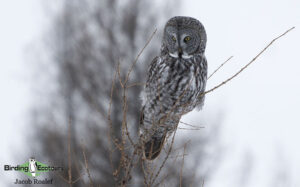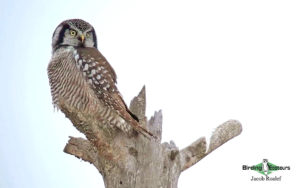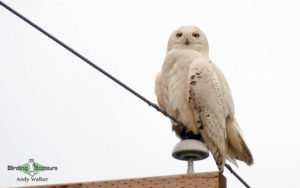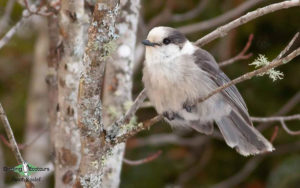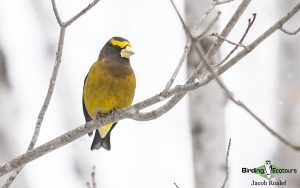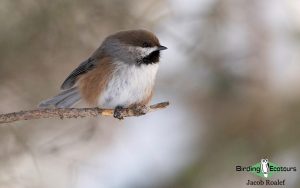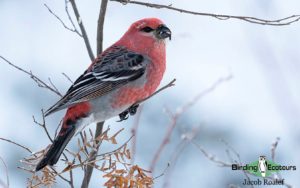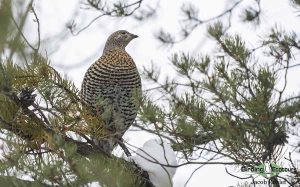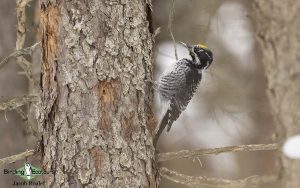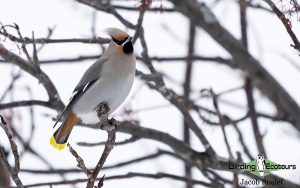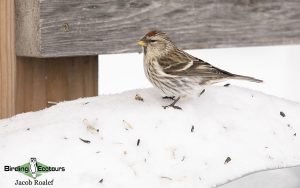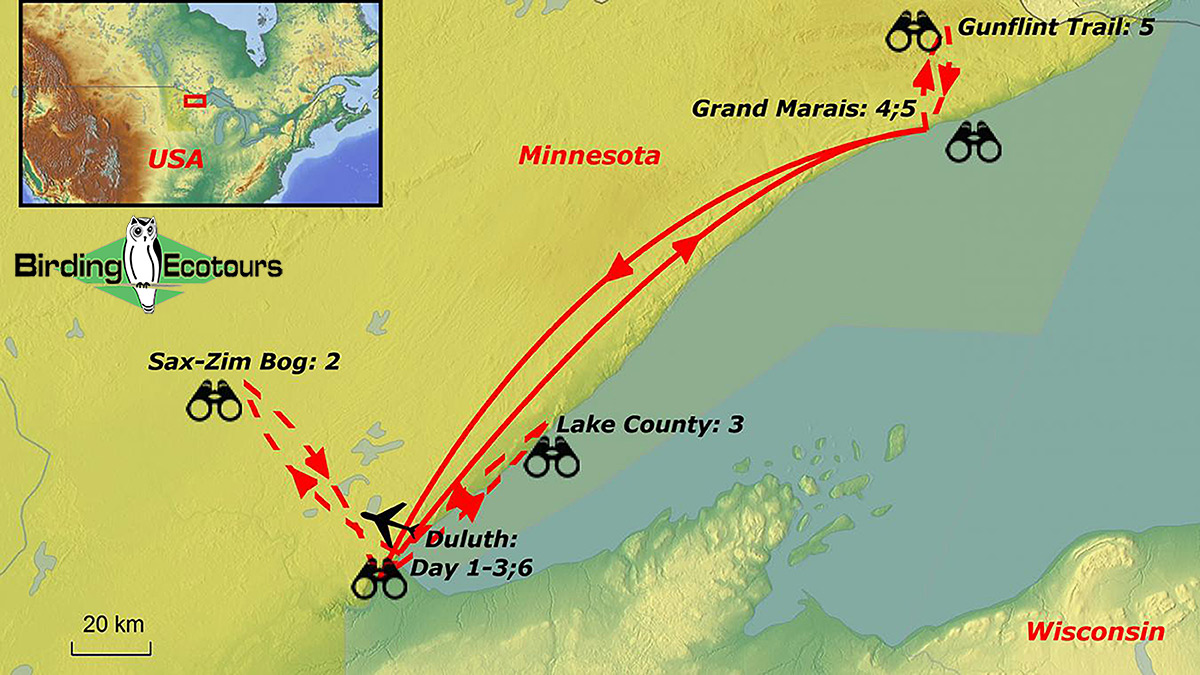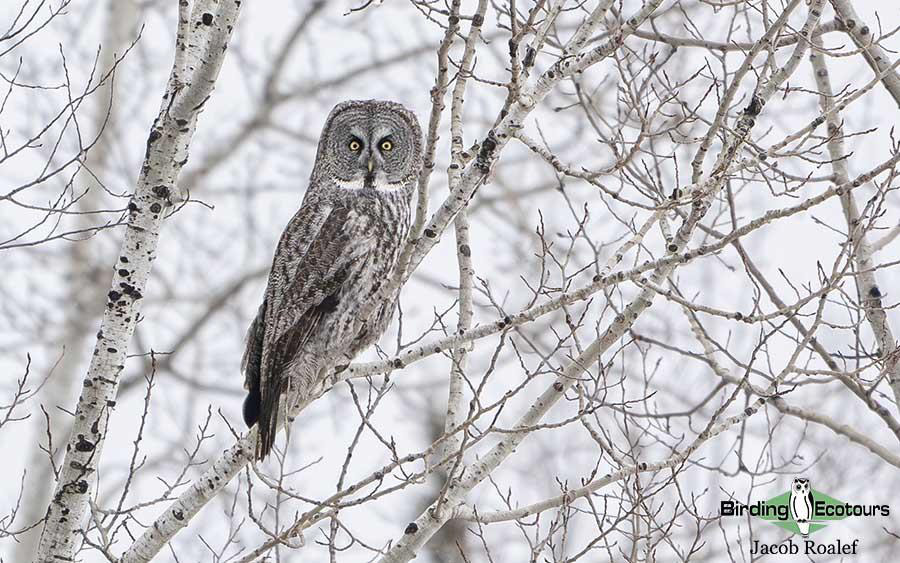Owls and Winter Birding in the Boreal Forest of Minnesota
Go to: USA Birding Tours | Birding Tours in North America | Owls of the World Tours | Tours by destination - List
Owls and Winter Birding in the Boreal Forest of Minnesota
January 2025
In true winter wonderland fashion, Minnesota offers picturesque scenes of snow-covered evergreens and iced-over lakes. This short Minnesota birding tour focuses on a variety of birds that use Lake Superior and the boreal forest as their winter homes. The famous USA birding location, Sax-Zim Bog, offers an incredible variety of habitats and is undoubtably one of the best places for amazing owls like Great Grey Owl, Northern Hawk-Owl, and Boreal Owl. Of course, the bog features more than just owls with other incredible boreal bird species including Evening Grosbeak, Pine Grosbeak, Ruffed Grouse and Black-backed Woodpecker. After a few days focused at Sax-Zim Bog, the tour moves up the coast of the mighty Lake Superior towards the small town of Grand Marais, stopping at a few birding areas along the way. A run through Superior National Forest, and other nearby state parks on the way north, offers a good chance at spotting Spruce Grouse and Boreal Chickadee. Just north of Grand Marais, the Gunflint Trail is known to hold some irruptive finch species such as Common Redpoll and Red Crossbill, with luck together with less frequent species such as Two-barred (White-winged) Crossbill and tantalizing ones. After scoring these fantastic winter denizens and many more, the tour concludes back in Duluth where folks can thaw out and make their journeys home after another unforgettable experience.
Have a look at our tour video summary which discusses the route and many highlights of this tour.
Itinerary (6 days/5 nights)
Day 1. Arrival at Duluth International Airport
After arrival, if there is time, we will bird around the Duluth area until dinner. We’ll try Canal Park and Wisconsin Point landfill for Glaucous and Iceland Gulls. We might also see the giant Great Black-backed Gull. As the sun begins to set, we will begin our search for the breathtaking Snowy Owl in the Duluth-Superior Harbor. Dinner will taste so much sweeter after a hopefully successful owl search. Then off to our hotel for a good night’s rest before starting our first full day of birding.
Overnight: Duluth
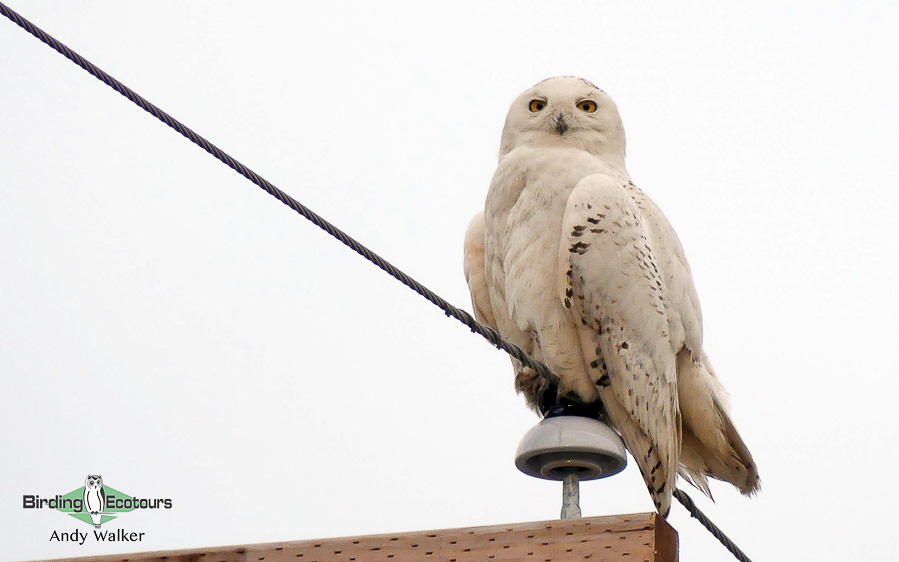
Days 2-3. Birding the famous Sax-Zim Bog Important Bird Area (IBA)
These next two days will focus exclusively on birding the giant area of the Sax-Zim Bog IBA. With its combination of open meadows, aspen and thick evergreen stands, rivers, farmlands, and more, it is no wonder so many boreal species call “the bog” home in the winter. Due to the extremely cold conditions of Minnesota in the winter, we will do most of our birding along the roadsides, never straying too far from the vehicle. We will cruise the roads in the mornings hopeful for a Black-billed Magpie mixed in with the American Crows and Common Ravens.
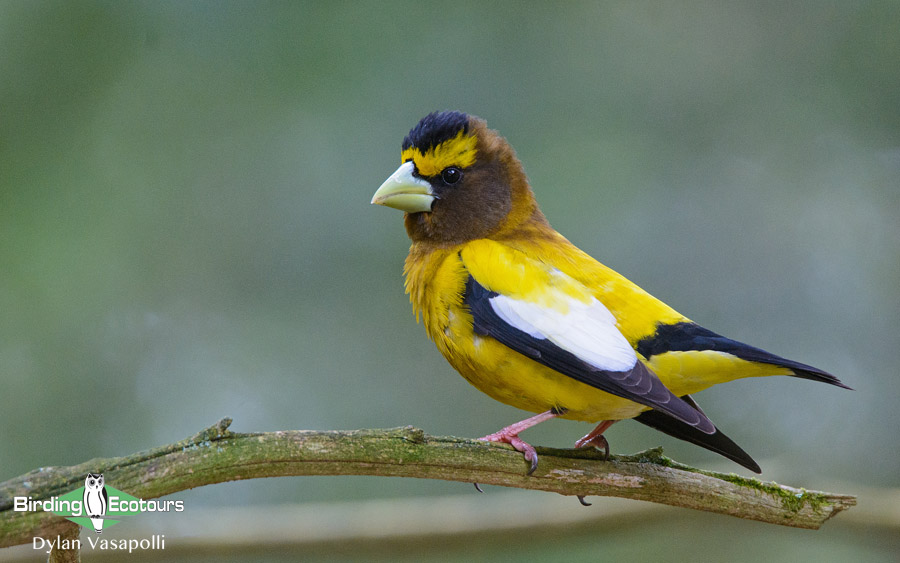
The southern portion of the bog is home to a known Sharp-tailed Grouse lekking area and sometimes these sneaky birds will visit a nearby feeder in the winter. Using various feeder setups throughout the area will be key as several of our targets enjoy the free buffet including Pine and Evening Grosbeaks, Black-capped Chickadee, Canada Jay, and even a hungry Great Grey (Northern) Shrike, from time to time. While driving around this vast area, we will keep our eyes peeled for silhouettes in the empty branches as Ruffed Grouse and North American Porcupines feed and rest. The open meadows play host to a nice variety of diurnal raptors including Bald Eagle, Rough-legged Buzzard (Hawk) and Northern Hawk-Owl. As day turns into evening, the anticipation builds for an appearance of the amazing Great Grey Owl silently hunting the roadsides and snowbanks. We will spend two full days exploring this amazing area which will certainly yield us some fantastic birding.
Overnight: Duluth
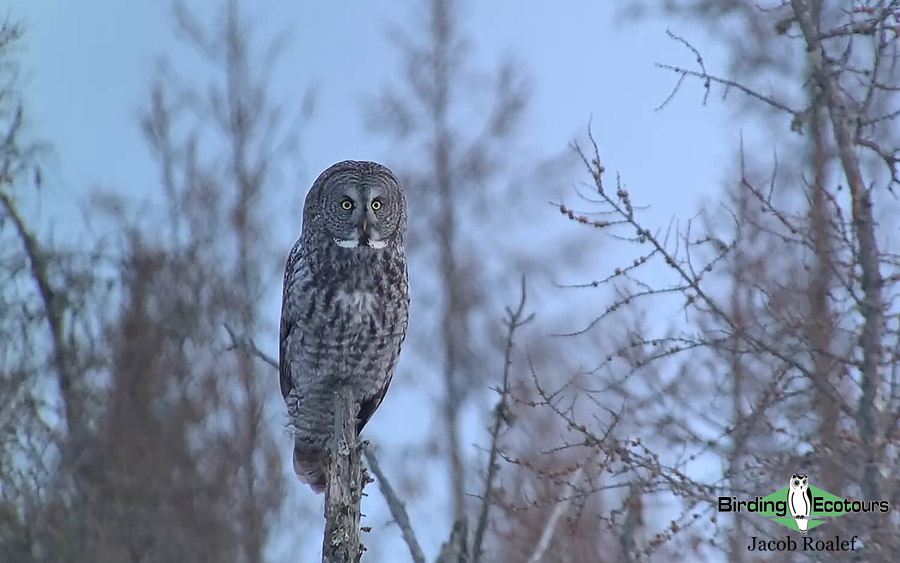
Day 4. Heading north and Superior National Forest
Today we will start our journey north to the small town of Grand Marais with a birding stop in Superior National Forest first. An early morning start will have us slowly patrolling the roadsides, searching for Spruce Grouse, which pick at the roadside grit and salt. As the sun continues to rise, finch flocks of American Goldfinches and Pine Siskins begin their sporadic flights, searching for seed pods. We will continue our birding of the great forest listening and looking for Boreal Chickadees and American Three-toed and Black-backed Woodpeckers. After a nice morning and afternoon of birding, we will arrive in Grand Marais. With our last few hours of light, we will scan the harbor for a potential Long-tailed Duck, Red-breasted Merganser, or Common Goldeneye.
Overnight: Grand Marais
Day 5. The Gunflint Trail and Grand Marais
A National Scenic Byway, the Gunflint Trail, curves its way north through the hills of Superior National Forest and along the edge of the US/Canadian Border. We will enjoy several scenic views along this 57-mile (92-kilometer) road this morning, stopping occasionally at safe pull offs. The far-reaching white pines combined with a bit of altitude make for a finch hotspot including species like Purple Finch, House Finch, Red Crossbill, Two-barred (White-winged) Crossbill and Pine Siskin. The cute Red-breasted Nuthatch and occasional Hairy Woodpecker can be found mixed in with these foraging finch flocks along the trail. The afternoon will be spent birding around the town and campgrounds of Grand Marais for roaming flocks of Cedar and Bohemian Waxwings feeding on the prevalent berries in the area. We will take one last check of the harbor and lake for any waterfowl or gulls we might be missing before calling it a day.
Overnight: Grand Marais
Northern Hawk-Owl will hopefully be another delight in Minnesota.
Day 6. Back to Duluth and departure home.
On our final day, we will make the trip south along the Lake Superior shoreline, back to Duluth, to catch our flights home. We recommend getting an afternoon or evening flight if possible. Depending on timing, we may be able to make one or two more birding stops along the way. The tour will conclude with a drop off at the Duluth International Airport.
Please note that the itinerary cannot be guaranteed as it is only a rough guide and can be changed (usually slightly) due to factors such as availability of accommodation, updated information on the state of accommodation, roads, or birding sites, the discretion of the guides and other factors. In addition, we sometimes have to use a different international guide from the one advertised due to tour scheduling.
Download ItineraryMinnesota: Set Departure Trip Report, January 2024
22 – 27 JANUARY 2024
By Lucas Corneliussen, with Jacob Roalef
DOWNLOAD TRIP REPORT
The majestic Great Grey Owl is always a top highlight of this trip!
Overview
This year’s six-day trip commenced in Duluth, Minnesota on the 22nd of January 2024, and concluded there on the 27th of January 2024. Unlike most trips, almost all the trip participants arrived ahead of time, allowing for extra birding time on the 22nd. Over the course of the tour, we visited several renowned birding locations, including Sax-Zim Bog, Winterberry Bog, Superior National Forest, and Grand Marais Harbor. We also visited some new locations for the tour including Bowen Lodge and the quiet town of Ely.
Fortunately, this tour was able to locate several of the amazing target birds, yielding a list of very high-quality species despite the low numbers in the region. Avian highlights included Great Grey Owl, Northern Hawk-Owl, Barred Owl, Evening and Pine Grosbeaks, Common Redpoll, Glaucous Gull, Long-tailed Duck, Canada Jay, Ruffed Grouse, Black-billed Magpie, Pileated Woodpecker, Red Crossbill, Snow Bunting, and a breathtaking experience with Bohemian Waxwing and Townsend’s Solitaire. A total of 49 bird species were recorded, along with a few great mammals, including Canada Lynx, Red Squirrel, and White-tailed Deer. The complete trip list, both birds and mammals, can be found below.

This Barred Owl gave some incredible views and even showed off its impressive talon to us.
Detailed Report
Day 1, 22nd January 2024. Sax-Zim Bog
Unlike most years, many of the participants arrived in Duluth the day before the trip began. Unfortunately, Ira and Ramona had some issues with their arrival the previous evening, but they were able to take the flight the following day from Minneapolis to Duluth. After dropping off their gear and changing, the group set off for our first stop: Sax-Zim Bog. We arrived at Byrne’s Greenhouse (along Highway 7) and were immediately greeted with a very cooperative Northern Hawk-Owl! We loaded back into the van and headed down Admiral Road — making a quick stop to see our first Canada Jay of the trip before arriving at the feeder station. Within the first five minutes, a Boreal Chickadee made a fast appearance along with several other species, including Hairy and Downy Woodpeckers, Common Redpolls, and Black-capped Chickadees. By noon, most of us were hungry, so we headed to lunch (Wilbert’s Cafe), but along the way, we found a Great Grey (Northern) Shrike perched high up in a pine along the road.
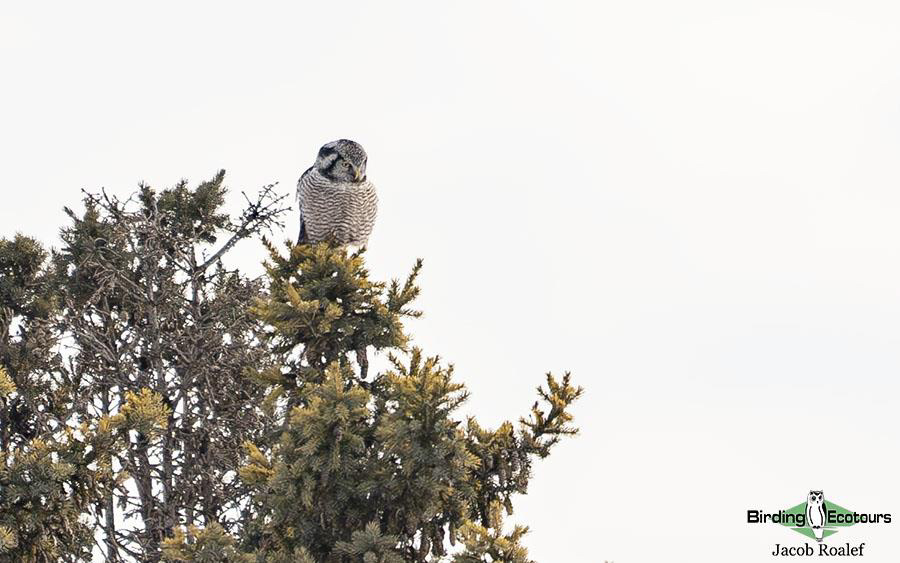
Northern Hawk-Owl is often seen perched at the apex of an evergreen.
After lunch, we headed to Winterberry Bog and walked along the snow-laden boardwalk. There, we had great experiences with our first Red-breasted Nuthatches, Blue Jays, and American Goldfinches of the trip, and redpolls once again offered spectacular views. Following our walk, we headed west along Arkola Road and hung out at the “hidden feeders,” where another Boreal Chickadee quickly moved through, along with adorable Red Squirrels. After a while, the cold began to set in, so we headed down Owl Avenue to the Sax-Zim Bog Visitor Center, where we spent time watching the Common Redpolls playing in the snow at close range. We then returned to Arkola Road, where six Ruffed Grouse were perched high in a leafless tree. As we continued along the road, BOOM — a Barred Owl nicely sat out in the open, allowing fantastic looks and photo opportunities. Slowly cruising down Highway 7 in the low light, we stumbled across our first gentle giant — the Great Grey Owl. Perched down the track, we watched this magnificent beauty for about 15 minutes before disappearing into the bog’s wooded depths. After a spectacular start to the trip, we drove back to Duluth for a tasty dinner before heading back to the hotel for some much-needed rest.
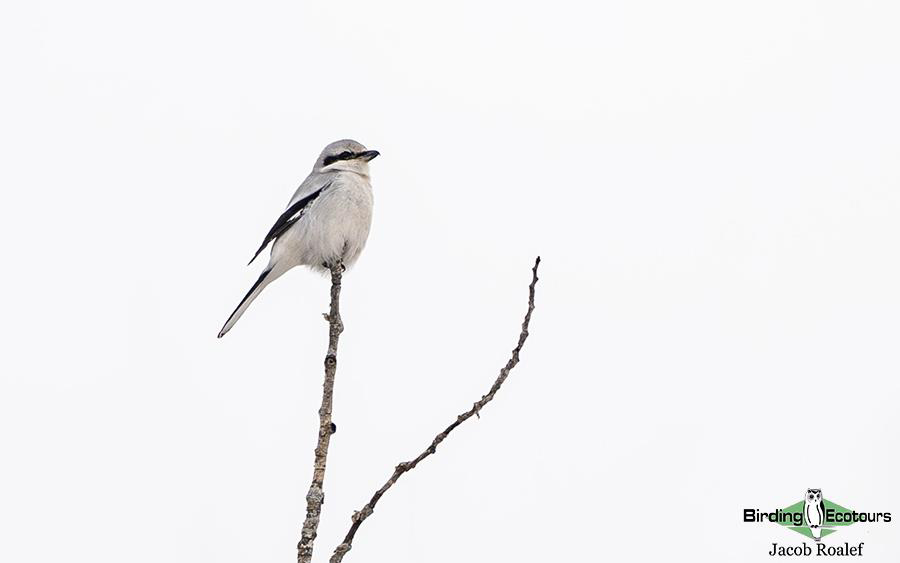
Great Grey (Northern) Shrike was seen on several days throughout Sax-Zim Bog.
Day 2, 23rd January 2024. More Sax-Zim Bog and the Duluth Waterfront
We departed bright and early for our first morning hours at Sax-Zim Bog. To begin the day, we returned to the area where we had seen the Great Grey Owl the previous evening. Once again, the bird sat atop a snag about 300 feet (~100 meters) down the track. We spent about 45 minutes watching the owl and waiting for it to come closer, but as the day progressed, it opted to head back into its forested home. A fast-flying Snow Bunting rattled as we loaded back into the van. We continued along Highway 7 and found the same Northern Hawk-Owl perched on a distant willow. We spent the next 25 minutes watching the owl and were delighted to witness a Great Grey (Northern) Shrike happily sitting on top of a willow. We continued down Admiral Road again and waited an hour, watching the northerly feeder station. Patiently waiting, we enjoyed the local specials before a pair of Boreal Chickadees joined the feeding frenzy along with a small family group of highly cooperative Canada Jays.
Excited by our success, we headed northwest towards the infamous “Mary Lou’s Feeders.” On the drive, we were surprised to find a nice rafter of Wild Turkeys! Upon arrival at Mary Lou’s, we were delighted to find several Evening Grosbeaks visiting the feeders, later joined by a group of 30 individuals. We were also excited to see our first Purple Finches and Pine Siskins of the trip feeding on the sunflower seeds.
By noon, we began heading south back towards Duluth for the afternoon. But first, we slowly made our way through the Meadowlands and turned up a single, Black-billed Magpie. It was quite distant, however, and only a few group members could get on it, leaving us desiring better looks. Driving back to Duluth, we stopped for lunch before continuing to the Lake Superior waterfront. We stopped at Canal Park, where we encountered our first American Herring Gulls and Mallards of the trip. Walking along the ice-covered lake — a large flock of Common Goldeneye whizzed by before landing in the only open water in the harbor, allowing for stunning views at close range. Continuing towards the van, WHAM — a Merlin carrying a House Sparrow zoomed by the group and landed in a nearby tree. The whole group marveled as we watched it pull the sparrow apart. It was gruesome but amazing to witness.
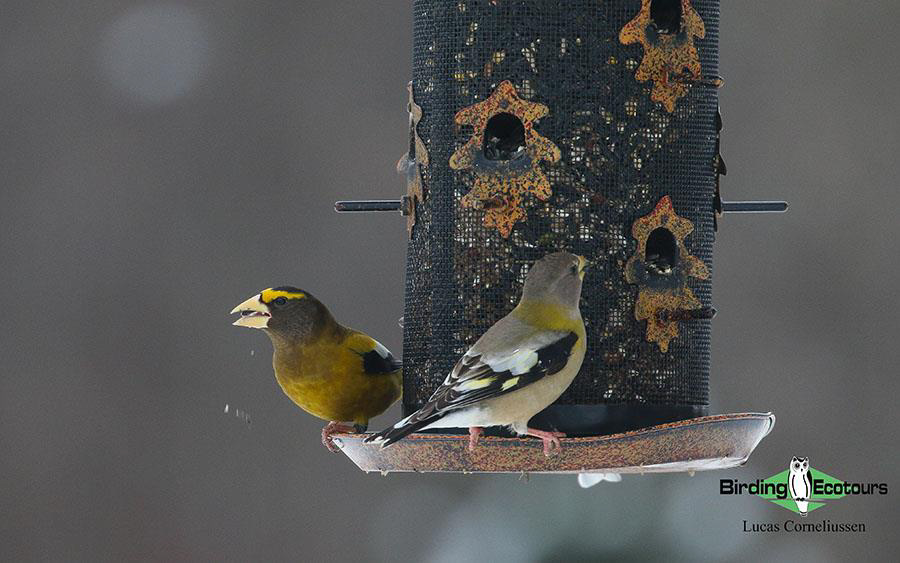
Continuing along the waterfront, we arrived at Park Point and watched the ice fishermen in their tents on the frozen harbor. Walking up the boardwalk toward the beach, we began scoping Lake Superior, and a female Long-tailed Duck flew by and headed west. Unfortunately, only a few could get on the bird, but as we were driving to our final location of the day, we saw a large flock of Mallards clustered together on the frozen lake, joined by several American Black Ducks and a Mallard x American Black Duck hybrid. Arriving at our final location for the day, in fading light, we arrived at Pier B and scoped the large gull flock on the ice flows. Two magnificent juvenile cycle Glaucous Gulls sat within a large flock of American Herring Gulls. One was a first cycle, and the other was a third cycle, allowing for a nice comparison of different age groups. As the daylight diminished, we headed to dinner before returning to the hotel.
Day 3, 24th January 2024. Sax-Zim Bog Finale and Bowen Lodge
Leaving the hotel a bit earlier than the previous few days, we headed north towards Sax-Zim Bog for our final morning there. After a 40-minute drive from Duluth, we again headed up Highway 7 and located the Great Grey Owl in its usual spot perched atop a snag about 300 feet (~100 meters) down the track. It took off early this morning into the woods and did not offer the group desired views. Driving down McDavitt Road, we stumbled upon our long-awaited nemesis: Black-billed Magpie. It had perched in an open location, allowing for good views of this sleek and majestic corvid. After a successful magpie experience, we headed down Arkola Road and attempted to get one last experience with the deep boreal species. After watching the Arkola Feeders for about half an hour, a male Pine Grosbeak dropped into the feeders and was later joined by a female.
We watched the pair feed on sunflower seeds for nearly ten minutes before returning to the bog. Driving down Owl Avenue on our way to the bathrooms at the visitor center, we stumbled upon what we had been waiting for the entire trip up to this point, a Great Grey Owl at point-blank range. The grey ghost of the boreal forests peacefully sat in a birch tree, carefully watching, and listening to its surroundings. A flutter — bam! The owl quietly departed its perch and pounced on a vole below the tree where it was sitting. Sitting in the snow, it downed the vole in one go before it began walking out into the open on the ground, in its snowy environment. It took off and, just like that, disappeared into the bog as if nothing had happened, leaving the group utterly speechless. Struggling to comprehend fully what we had just witnessed, we continued to the Sax-Zim Bog Visitor Center for a quick look at the feeders before heading west.
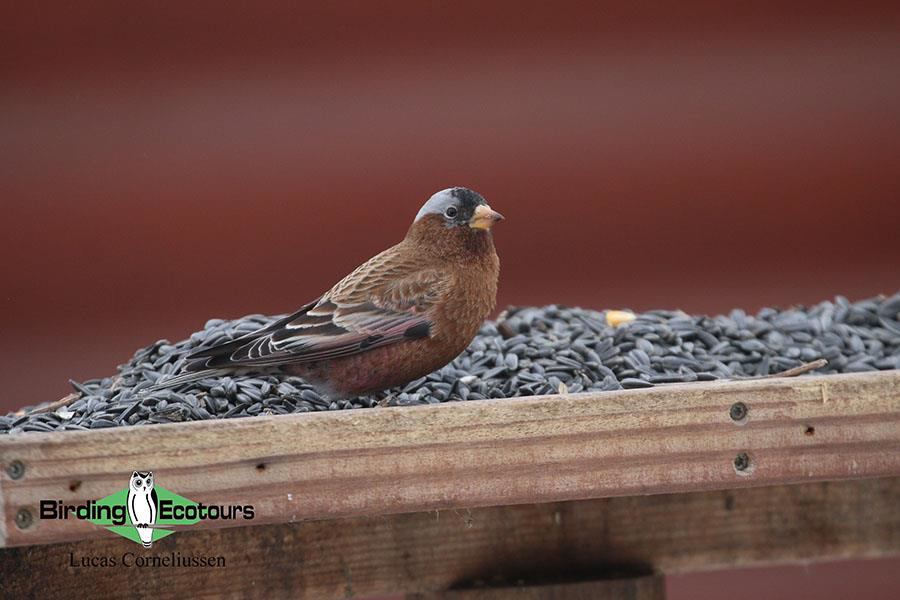 This Grey-crowned Rosy Finch was a true rarity for the region!
This Grey-crowned Rosy Finch was a true rarity for the region!
We then began the long drive to Itasca County to search for a reported, Grey-crowned Rosy Finch. After an hour-and-a-half-long drive, we arrived at our destination, Bowen Lodge (Lake Winnibigoshish). Waiting patiently in the cold, watching the local Hairy Woodpeckers feed on the sunflower seeds, a Red-bellied Woodpecker dropped into the feeders. Nearly an hour later, in 24°F (-4°C) temperatures, the Grey-crowned Rosy Finch dropped down from the adjacent Poplar Tree and landed on the seed feeder, allowing for spectacular views at close range. Admiring the rosy finch until it left the feeder, we turned east and began the trek back toward Sax-Zim Bog.
Halfway through the drive, we made a stop for lunch in Deer Park and a stop to take a photo along the headwaters of the Mississippi River. We arrived at Mary Lou’s Feeders in the hopes of relocating some of the same species we had seen the previous day, yet we had little luck in that endeavor. We, however, found our only Mourning Doves of the trip, another rafter of Wild Turkeys, and a small herd of White-tailed Deer. In the fading late, we headed south along McDavitt Road, and suddenly, Debi called out, “Mammal!” We immediately backed up, and standing in the field on the north side of the road was a Canadian Lynx! It quickly bounded into the woods and did not allow for good looks, but its large grey body and pointed ears made its identity clear. We continued down the road and stumbled upon a beautiful Barred Owl, which unfortunately only allowed for fleeting views before it flew back into the depths of the wooded bog. As the daylight disappeared, we returned to Duluth for some pizza before returning to the hotel for the evening.
Day 4, 25th January 2024. Woodpecker Day! Plum Creek and Johnson Roads and Grand Marais Waterfront
Despite some less-than-ideal forecasted weather conditions, we headed north toward the Canadian border in search of woodpeckers in northern St. Louis County. We were in search of boreal-specialist woodpeckers. We arrived after an hour’s drive at Plum Creek Road. The dense spruce-covered area appeared perfect for the species we had in mind, and it took us only a short time to find our first target of the day, American Three-toed Woodpecker. This magnificent boreal woodpecker put on quite the show, allowing the group to get fantastic looks and photos at close range. After half an hour, the woodpecker decided it was time to go, and we opted to do the same. Continuing through the boreal zone, we arrived at Johnson Road after a fast half-hour drive. A mix of living and dead spruce trees lined the snow-dusted road, and after walking half a mile down the road, we stumbled into our second target of the day, a male Black-backed Woodpecker. Watching it glean the trunks of the snow-covered spruces, a female joined it, and then a few minutes later, another male joined the group. Enjoying the birds at close range, we watched them for about 15 minutes before disappearing into the dense timberland. The only other bird we saw on Johnson Road was a Northern (Common) Raven.
Famished, we headed to the small town of Ely for lunch. But before we sat down for lunch, we found a Mountain Ash Tree with eight female Pine Grosbeaks! Sitting down for lunch, we enjoyed the warmth of the café before heading back out to search for trees with berries in town. Despite our best efforts, we could not find any and decided to continue. Driving about an hour down the highway towards Lake Superior, we stopped along Highway 2 and almost immediately located a mixed winter flock, which held a dozen Red Crossbills! Feeding on the pinecones over 50 feet (15 meters) up, we watched them pick at their meal while being serenaded by the thunderous call of a Pileated Woodpecker. Fifteen minutes later, the crossbills decided it was time to move on, and we did the same. Arriving in Grand Marais near sunset, we spent the last remaining light in the harbor and were pleased to find a small raft of eight Long-tailed Ducks and half a dozen Common Goldeneyes. As the light disappeared, we headed to the hotel to check in and decompress for an hour, before heading to dinner in town for a much-needed meal. Returning to the hotel later that evening, we headed to bed fully fed and ready for another day!
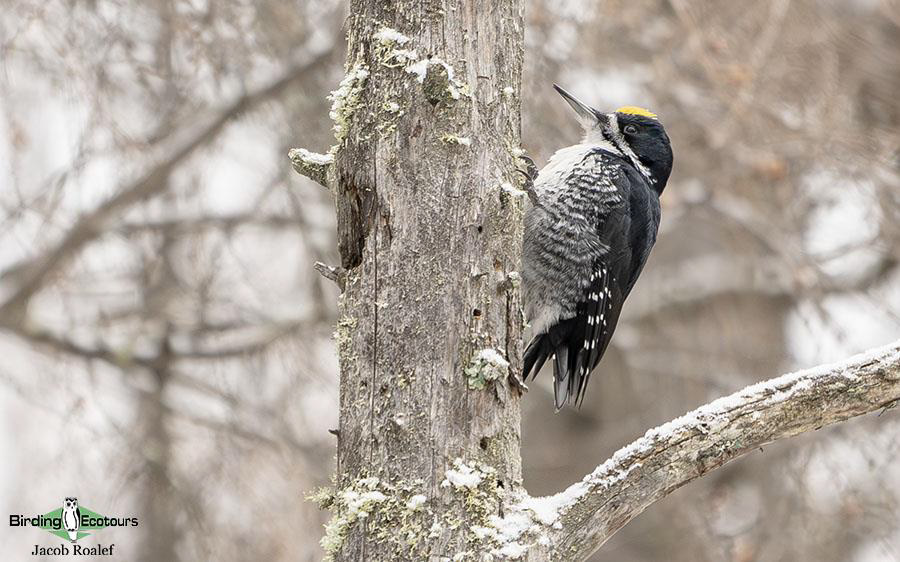
This Black-backed Woodpecker put on quite a show for the group.
Day 5, 26th January 2024. Gunflint Trail and Grand Marais
Waking up for our final full day of birding with excitement, we ate breakfast at the hotel before driving up the Gunflint Trail into the Superior National Forest. Slowly working our way north, we were enchanted to find the forest: quite literally a winter wonderland. The previous day’s warm temperatures had allowed the tree branches to crystallize in the night, giving the appearance of an icy utopia. Arriving at our first stop after about an hour, we slowly walked along a snow-covered forest road and witnessed the Minnesotan winter in full effect. Watching a pair of Red-breasted Nuthatches make their eerily loud “yenk, yenk, yenk” calls, they made their way toward us, allowing for great looks. We meticulously searched the wintery landscape and came across a small family group of Black-capped Chickadees and a Downy Woodpecker. As we headed back towards the car, it began to snow on us, emphasizing the serenity of the area.
Loading back up in the vans, we continued to head north and stopped at the Trail Center Lodge and Restaurant to see if they had their feeders up this winter; however, we learned they had yet to be put up. As a consolation prize, we walked down the path to Poplar Lake, which had frozen over, and it allowed those brave enough, to walk on it. Heading back to Grand Marais, we continued to cruise the road slowly before arriving in Grand Marais for a quick lunch. After replenishing our appetites, we headed down to the harbor and located a trio of male Red-breasted Mergansers just beyond the jetty, as well as a cluster of American Herring Gulls on the ice. Returning to the neighborhoods we had quickly driven through the previous day, we made our way up 8th Avenue, and sitting at the very top of a poplar was a flock of over 200 Bohemian Waxwings.
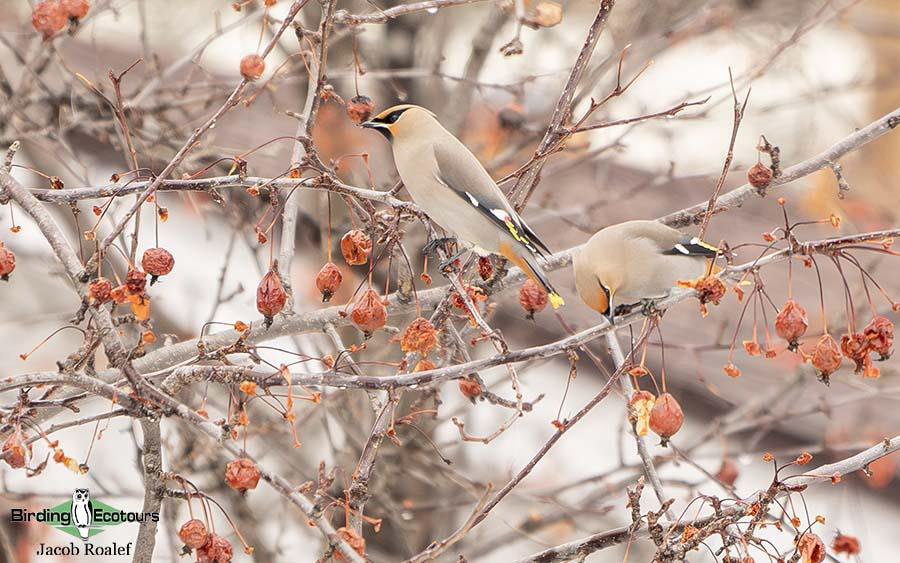
Bohemian Waxwings decimated the berry trees in Grand Marais.
We watched as the flock would rotate from the high poplars down to the low berry tree, some even going down onto the snow. Ten minutes later, we watched as the entire flock departed. During the frenzy of the waxwing spectacle, a Townsend’s Solitaire made a brief appearance, but fortunately, we were eventually able to track it down, a few blocks down the road and got fantastic eye-level views. Heading back down to the icy harbor, we visited the northern section, and as we pulled up, another group of over 50 Bohemian Waxwings were perched up in a poplar in the parking lot. They only stuck around briefly, allowing us to begin scanning north with our scopes. Mary Lou suddenly spotted a large raft of ducks on the horizon. When we brought the scopes over, the entire flock suddenly vanished. Fortunately, they resurfaced, and it turned out to be a massive flock of over 150 Long-tailed Ducks. They had an interesting behavioral trait that led them to simultaneously dive in a synchronous pattern, likely to feed, explaining their sudden disappearance. Unfortunately, they were quite distant and did not allow for close photography. As we continued in the harbor, we turned the corner and found a second flock of 25 Long-tailed Ducks at a much closer range, allowing for much better photography conditions. With a few hours of daylight remaining, we opted to head back up the Gunflint Trail and re-walk the same trail we had done earlier in the day. Despite our best efforts, we could not find anything new, and we headed back to Grand Marais as the daylight faded. We headed back to the hotel for a quick break before heading to our final dinner of the trip. Feeling satisfied, we returned to our beds and rested for our final morning.
Day 6, 27th January 2024. Departure day and final birding
Our final morning in Minnesota. After eating breakfast at our hotel in Grand Marais, it was time to depart for Duluth for our flights home. Driving back along Lake Superior, we took in the breathtaking views and headed west. We stopped in Two Harbors for gas and restrooms and were delighted to find the Dickcissel, which had been hanging out with the local House Sparrow flock. However, it took a while to re-find it, given that an immature, Sharp-shinned Hawk was eyeing the flock from afar. Pushing further west, we made one last attempt at the dump. We found a flock of ducks in the outflow, which held the only Greater Scaup of the trip among the Mallards and American Black Ducks. We continued to the composting piles and found half a dozen Glaucous Gulls perched atop one of the buildings with the other gulls. Before heading to the airport, we had a quick lunch break and said our goodbyes. We headed to the airport and departed with memories that are certain to last a lifetime!
Bird List – Following IOC (13.2)
Birds ‘heard only’ are marked with (H) after the common name, all other species were seen.
The following notation after species names is used to show conservation status following BirdLife International: CE = Critically Endangered, EN = Endangered, VU = Vulnerable, NT = Near Threatened.
| Common Name | Scientific Name |
| Ducks, Geese, and Waterfowl (Anatidae) | |
| Mallard | Anas platyrhynchos |
| American Black Duck | Anas rubripes |
| Greater Scaup | Aythya marila |
| Long-tailed Duck – VU | Clangula hyemalis |
| Common Goldeneye | Bucephala clangula |
| Red-breasted Merganser | Mergus serrator |
| Pheasants, Grouse, and Allies (Phasianidae) | |
| Ruffed Grouse | Bonasa umbellus |
| Wild Turkey | Meleagris gallopavo |
| Pigeons and Doves (Columbidae) | |
| Rock Dove | Columba livia |
| Mourning Dove | Zenaida macroura |
| Gulls, Terns, and Skimmers (Laridae) | |
| American Herring Gull | Larus argentatus |
| Glaucous Gull | Larus hyperboreus |
| Hawks, Eagles, and Kites (Accipitridae) | |
| Sharp-shinned Hawk | Accipiter striatus |
| Bald Eagle | Haliaeetus leucocephalus |
| Red-tailed Hawk | Buteo jamaicensis |
| Owls (Strigidae) | |
| Northern Hawk-Owl | Surnia ulula |
| Barred Owl | Strix varia |
| Great Grey Owl | Strix nebulosa |
| Woodpeckers (Picidae) | |
| Red-bellied Woodpecker | Melanerpes carolinus |
| American Three-toed Woodpecker | Picoides dorsalis |
| Black-backed Woodpecker | Picoides arcticus |
| Downy Woodpecker | Dryobates pubescens |
| Hairy Woodpecker | Dryobates villosus |
| Pileated Woodpecker (H) | Dryocopus pileatus |
| Falcons and Caracaras (Falconidae) | |
| Merlin | Falco columbarius |
| Shrikes (Laniidae) | |
| Great Grey (Northern) Shrike | Lanius borealis |
| Crows, Jays, and Magpies (Corvidae) | |
| Canada Jay | Perisoreus canadensis |
| Blue Jay | Cyanocitta cristata |
| American (Black-billed) Magpie | Pica hudsonia |
| American Crow | Corvus brachyrhynchos |
| Northern (Common) Raven | Corvus corax |
| Tits, Chickadees, and Titmice (Paridae) | |
| Black-capped Chickadee | Poecile atricapillus |
| Boreal Chickadee | Poecile hudsonicus |
| Nuthatches (Sittidae) | |
| Red-breasted Nuthatch | Sitta canadensis |
| White-breasted Nuthatch | Sitta carolinensis |
| Starlings (Sturnidae) | |
| Common Starling | Sturnus vulgaris |
| Thrushes and Allies (Turdidae) | |
| Townsend’s Solitaire | Myadestes townsendi |
| Waxwings (Bombycillidae) | |
| Bohemian Waxwing | Bombycilla garrulus |
| Old World Sparrows (Passeridae) | |
| House Sparrow | Passer domesticus |
| Finches, Euphonias, and Allies (Fringillidae) | |
| Evening Grosbeak – VU | Coccothraustes vespertinus |
| Pine Grosbeak | Pinicola enucleator |
| Purple Finch | Haemorhous purpureus |
| Common Redpoll | Acanthis flammea |
| Red Crossbill | Loxia curvirostra |
| Pine Siskin | Spinus pinus |
| American Goldfinch | Spinus tristis |
| Grey-crowned Rosy Finch | Leucosticte tephrocotis |
| Longspurs and Snow Buntings (Calcariidae) | |
| Snow Bunting | Plectrophenax nivalis |
| Cardinals and Allies (Cardinalidae) | |
| Dickcissel | Spiza americana |
| Total Seen | 48 |
| Total Heard | 1 |
| Total Recorded | 49 |
Mammal List
| Common Name | Scientific Name |
| Sciuridae (Squirrels and Allies) | |
| Eastern Grey Squirrel | Sciurus carolinensis |
| Red Squirrel | Tamiasciurus hudsonicus |
| Felidae (Cats) | |
| Canada Lynx | Lynx canadensis |
| Cervidae (Deer) | |
| White-tailed Deer | Odocoileus virginianus |
| Total | 4 |
DOWNLOAD TRIP REPORT
This is a sample trip report. Please email us ([email protected]) for more trip reports from this destination.
PREPARING FOR MINNESOTA IN WINTER
A Great Grey Owl descends silently upon an open field to catch a vole hidden in the deep snow. Flocks of colorful winter finches noisily visit a feeder, rivaling even the tanagers of the tropics in color. Grouse strut along an open field with their amazing snowshoe-like feet, perfectly adapted in both form and color to the depths of winter. These are the images that come to mind when one thinks of a birding trip to Minnesota in winter.
Although visiting this frigid state in winter may seem like madness to the uninitiated, the birds that occur in northeastern Minnesota are among some of the most special and charismatic in the world, such as Northern Hawk-Owl, Great Grey Owl, and Snowy Owl. Sitting on the southern edge of the vast boreal forest biome, northeastern Minnesota is the southern limit of distribution for many other boreal forest species that do not regularly occur further south, such as Boreal Chickadee and Grey Jay. However, one must keep in mind that a trip list to this state in January will only include about 40 or so hardy species, with few individuals overall. It will definitely be a case of quality over quantity.
Another factor to consider is the weather. Average high temperatures in Duluth in January range between 15 to 20 degrees Fahrenheit (-9 to -6 degrees Celsius), but it can potentially never go above 0 degrees Fahrenheit (-17 degrees Celsius) on some days. Although it will be very cold by most standards, most of our birding will be done along roadsides, either near or within the warmth of our vehicle. There may be a few very short walks of a couple of hundred meters/yards or less. Notwithstanding these details, please dress in multiple warm layers!
Download General Information Minnesota
Download What to bring
‘I thoroughly enjoyed my Minnesota birding tour with Jacob Roalef of Birding Ecotours in January of 2022. The tour was very easy to book, and the ongoing communication with the corporate office and with our guide, Jacob was exceptional. I always got a prompt response to email questions, which was important and reassuring. Jacob was extremely knowledgeable of the local area and the various birding hotspots in order to give us the best opportunity of locating the various species we had all come to see. I would highly recommend this tour!’
Chellye
‘Jacob was patient, funny, talked to all the participants, and made sure all members got on the birds. Jacob gave me good looks at and information on two life birds, Glaucous and Iceland Gulls. He was also an excellent driver, especially on the last day when we drove from Grand Marais in a snowstorm.’
Lynn
‘I had even more fun than I expected on this wonderful winter tour. The bird highlights were varied from chickadees to grouse to owls and the winter scenery along the lake was breathtaking. Jacob is an excellent guide and very knowledgeable about both the area in general and the birds. We had birders of various levels of experience in the group and everyone enjoyed the experience.’
Sherry
‘It was a trip that I liked very much and highly recommended. Jacob’s experience in birds and in the organization of everything made the trip run smoothly. The birds, many of them were new to me which was a delight.’
Susana
‘A great overview of Minnesota winter birding. Although the list of potential birds is somewhat limited because of the weather, the quality of what we did see more than made up for lack of quantity. Eleven of the 44 birds I saw were lifers, including Great Grey Owl, Boreal Chickadee, Pine Grosbeak, Sharp-tailed Grouse and more. Most spectacular was I saw my first Bohemian Waxwing and then about 1,000 more as part of a massive flock, feeding on berries throughout the town of Grand Marais. We were able to experience that over two straight days.’
Gene


